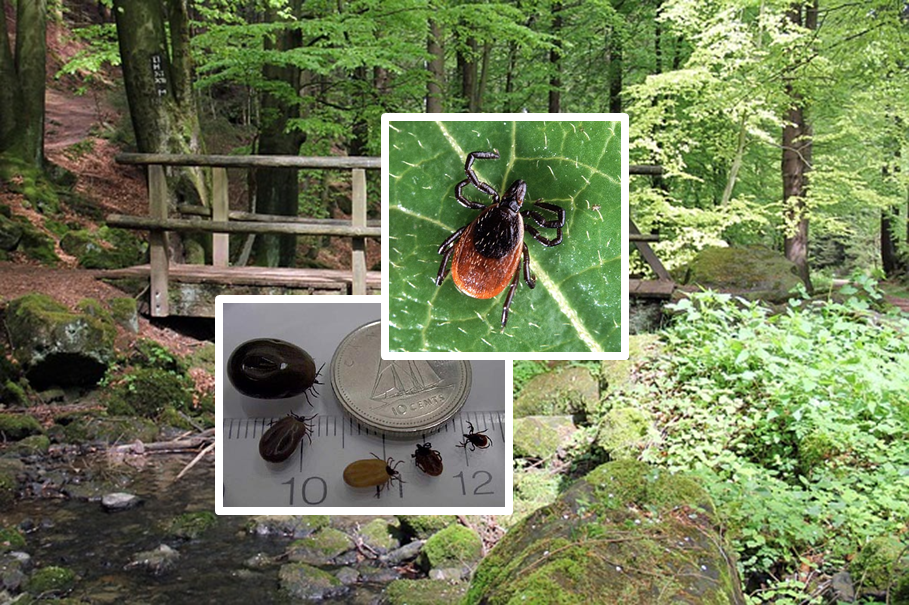Justin Bieber has revealed he was diagnosed with Lyme disease, an infection caused by bacteria commonly carried by ticks.
Following Justin Bieber’s diagnosis, here’s everything you need to know about Lyme disease.
Lyme Disease General Info
The females of many species of mosquitoes feed on blood, some of them transmit extremely harmful human diseases – West Nile virus, malaria, yellow fever and filariasis.
For this article, we’ve collected information about another ugly things: “hard ticks” and Lyme Disease that they can cause.
Lyme disease is an infectious disease caused by at least three species of bacteria belonging to the genus Borrelia. Borrelia burgdorferi is the main cause of Lyme disease in North America, whereas other two species cause most European cases. Borrelia is transmitted to humans by the bite of infected ticks belonging to a few species of the genus Ixodes.
The disease is named after the towns of Lyme and Old Lyme, Connecticut, US, where a number of cases were identified in 1975. Although it was known that Lyme disease was a tick-borne disease as far back as 1978, the cause of the disease remained a mystery until 1981, when B. burgdorferi was identified by Willy Burgdorfer.
Early symptoms may include fever, headache, and fatigue. A rash occurs in 70–80% of infected persons at the site of the tick bite after a delay of 3–30 days (average is about 7 days), and may or may not appear as the well-publicized bull’s-eye (erythema migrans). The rash is only rarely painful or itchy, although it may be warm to the touch. Approximately 20–30% of infected persons do not experience a rash. Left untreated, later symptoms may involve the joints, heart, and central nervous system. In most cases, the infection and its symptoms are eliminated by antibiotics, especially if the illness is treated early. Delayed or inadequate treatment can lead to more serious symptoms, which can be disabling and difficult to treat. The term “chronic Lyme disease” is controversial and not recognized in the medical literature, and most medical authorities advise against long-term antibiotic treatment for “chronic Lyme disease”.
The Public Health Agency of Canada conducts surveillance for Lyme disease in Canada
Lyme disease is a serious illness caused by the bacterium Borrelia burgdorferi, which can be spread through the bite of blacklegged ticks. The Public Health Agency of Canada (the Agency), in partnership with provincial and territorial public health authorities, conducts surveillance for Lyme disease in Canada and studies show that the incidence of this disease is on the rise in Canada.
Lyme infected ticks are found in most southern regions of Canada and risk areas are emerging in parts of southern British Columbia, Ontario, Quebec, Nova Scotia, New Brunswick and Manitoba.
Lyme disease in humans
Lyme disease is a multisystem illness caused by Borrelia burgdorferi, a spirochete transmitted by certain species of Ixodes spp. ticks, specifically the blacklegged tick and the western blacklegged tick. Borrellia burgdorferi causes Lyme disease in humans. The ticks transmit the bacterium to humans after becoming infected by feeding upon infected wild animal hosts, such as rodents and birds.
Lyme disease is the most commonly reported vector-borne disease in the northern temperate zone. It became a nationally notifiable disease in December 2009. As such, all healthcare professionals are to report cases of Lyme disease to the Agency via their provincial public health system.
The Agency currently has data for Lyme disease cases reported between 2009-2012:
- 2009: 128 cases
- 2010: 132 cases
- 2011: 258 cases
- 2012: 315 cases
The incidence of Lyme disease peaks in children between 5-9 years and adults between 55-59 years.
Lyme disease does not provide long-term immunity; post-treatment re-infection is possible.
Symptomatic infection of the heart is rare in recognized Lyme disease cases, but three sudden cardiac deaths associated with Lyme carditis were reported in the United States in 2012
Lyme Disease Clinical Presentation and Course
The clinical manifestations of Lyme disease largely reflect the biology of B. burgdorferi as it replicates in the skin and then disseminates via the bloodstream to other internal sites where disease can be seen (Bockenstedt, p. 283, 2008). Signs and symptoms appear in overlapping stages as early localized disease, early disseminated infection, or late disease.
Know the other clinical manifestations and risk factors, and consider them as part of your differential diagnosis. Accurate diagnosis is one of the key factors to successfully manage Lyme disease.
Localized Stage – Erythema migrans (EM)
The first and typical symptom of early non-disseminated Lyme disease is usually an expanding rash called erythema migrans (EM).
- occurs at the site of the infective tick bite within 1-2 weeks post infection (70% – 80% of infected people) and can persist up to eight weeks
- painless, erythematous skin lesion (≥5 cm in diameter)
- low-grade fever, fatigue, headache, and arthralgia
Early disseminated disease:
If untreated, the second stage of the disease can last up to several months and include the following symptoms:
- Neurological (15% – 20% of untreated patients) Bell’s palsy or other cranial neuropathy; meningitis; motor and sensory radiculoneuropathy, mononeuritis multiplex; subtle cognitive difficulties; encephalopathy radiculopathy, cranial neuropathy, and mononeuropathy multiplex)
- Cardiac (4% – 8% of untreated patients) – conduction abnormalities, e.g. atrioventricular node block; ventricular node block; myocarditis, pericarditis, sudden death)
- Rheumatological (60% of untreated patients) – Asymetric oligoarticular arthritis, especially involving the knees
- Cutaneous (multiple EM lesions)
- Additional manifestations (conjunctivitis, keratitis, uveitis; mild hepatitis; splenomegaly)
Late Lyme disease
If the disease remains untreated, the third stage can last months to years with the following symptoms:
- Rheumatologic (chronic arthritis, transient, migratory arthritis and effusion in one or multiple joints; migratory pain in tendons, bursae, muscle, and bone; Baker’s cyst; if untreated, arthritis may recur in same or different joints).
- Neurological (Subacute mild encephalopathy affecting memory and concentration, chronic mild axonal polyneuropathy manifested as distal paresthesias and less commonly, as radicular pain. Rarely, an encephaolomyelitis or leukoencephalopathy may occur.
- Cardiac (atrioventricular block, myocarditis, pericarditis)
Lyme Disease Transmission
Lyme disease is classified as a zoonosis, as it is transmitted to humans from a natural reservoir among rodents by ticks that feed on both sets of hosts. Hard-bodied ticks of the genus Ixodes are the main vectors of Lyme disease (also the vector for Babesia). Most infections are caused by ticks in the nymphal stage, as they are very small and may feed for long periods of time undetected. Larval ticks are very rarely infected. Although deer are the preferred hosts of deer ticks, and the size of the tick population parallels that of the deer population, ticks cannot acquire lyme disease spirochetes from deer. Rather, deer ticks acquire Borrelia microbes from infected rodents, such as the white-tailed mouse.
Tick bites often go unnoticed because of the small size of the tick in its nymphal stage, as well as tick secretions that prevent the host from feeling any itch or pain from the bite. However, transmission is quite rare, with only about 1% of recognized tick bites resulting in Lyme disease. Transmission may occur within 24 hours of the tick bite.
Lyme Disease Prevention
There is no vaccine for Lyme disease. The best way to avoid Lyme disease is to protect against tick bites. Health professionals should advise their patients to take the following measures:
- If there are ticks in your area, cover up if you think you might be exposed to them. Wear closed-toe shoes, long-sleeved shirts and pants. Pulling your socks over your pant legs prevents ticks crawling up your legs. Light-coloured clothing makes spotting ticks easier.
- Use insect repellents that contain DEET (concentration between 20-30%). Repellents can be applied to clothing as well as exposed skin. Always read and follow label directions.
- Shower or bathe within two hours of being outdoors. Daily “full body” checks for ticks should be performed: ticks attach themselves to the skin so they can be found and removed, which usually prevents infection if this is done early enough (within 24-48 hours). Be sure to check children and pets for ticks as well.
How to Remove a Tick
Attached ticks should be removed promptly, as removal within 36 hours can reduce transmission rates. Folk remedies for tick removal tend to be ineffective, offer no advantages in preventing the transfer of disease, and may increase the risks of transmission or infection. The best method is simply to pull the tick out with tweezers as close to the skin as possible, without twisting, and avoiding crushing the body of the tick or removing the head from the tick’s body. The risk of infection increases with the time the tick is attached, and if a tick is attached for less than 24 hours, infection is unlikely. However, since these ticks are very small, especially in the nymph stage, prompt detection is quite difficult.
Surveillance
The Agency works with the provinces, health authorities and other experts on research to define and monitor the occurrence of the ticks that carry Borrelia burgdorferi.
In Canada, the blacklegged tick (Ixodes scapularis , often referred to as a ‘deer tick’) and the western blacklegged tick (Ixodes pacificus) are the species that most commonly transmit this disease-causing agent, as well as other less common agents.
Other tick species are known to transmit Lyme disease in nature but these ticks rarely bite humans. The greatest risk of Lyme disease in Canada occurs where populations of these ticks are established, and where there is evidence that these established ticks are transmitting the agent of Lyme disease. These locations are termed ‘Lyme endemic areas’ as defined by Health Canada (1991). Knowledge of whether a patient has had exposure to these areas is important for Lyme disease diagnosis and reporting of Lyme disease cases.
Tick Populations in Canada
Our current knowledge of the occurrence of established tick vectors are based on active surveillance in the field. This distribution suggests that tick populations and Lyme endemic areas currently occur in a limited area of Canada; however surveillance indicates that established populations of blacklegged ticks are spreading their geographic scope, and are increasing in number, in much of southern Canada. The potential expansion of localized tick populations makes it difficult to precisely define the geographic limits of any given population; however people living or visiting areas adjacent to established tick populations may have a greater chance of contact with blacklegged ticks.
Known Lyme endemic areas in Ontario:
- Point Pelee National Park
- Rondeau Provincial Park
- Turkey Point Provincial Park
- Long Point peninsula including Long Point Provincial Park and the National Wildlife area
- Wainfleet bog region near Welland
- Prince Edward Point
- Parts of the Thousand Islands National Park
Enjoy your outdoor adventure!
… But keep in mind that better safe than sorry. Like people say “you never know”
- “The best six doctors anywhere
- And no one can deny it
- Are sunshine, water, rest, and air
- Exercise and diet.
- These six will gladly you attend
- If only you are willing.
- Your mind they’ll ease
- Your will they’ll mend
- And charge you not a shilling.”
This childish rhyme (quoted by Wayne Fields, What the River Knows, 1990) has a great deal of common sense in it. No kidding! But … There is always a “but”. There are some nuisances are involved such as blood-eating pests.



















